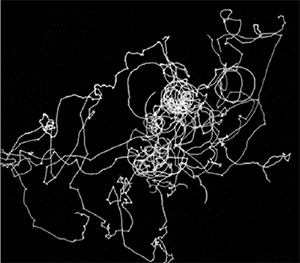Assistant Professor Mason Klein is fascinated by the movement and behavior of animals.
"Why do animals do what they do and how do they decide where to go? Also, what happens in the brain to make them behave this way? It's these questions that have intrigued me," said Klein, a faculty member in the departments of physics and biology in the College of Arts and Sciences.
Recently, Klein was given a National Science Foundation (NSF) CAREER Award Grant to dive deeper into his research studying the neurological and motor behavior of animals, like the fly larva he studies in his lab.
"Our basic goal is to understand how living systems take in information about their surroundings, process that information in their brains, then perform a physical action," adds Klein. "We use the fruit fly larva as a model system—it's a great animal for this because it moves slowly and is transparent, so we can see its neurons in action."
Fly larvae have only a few thousand neurons and make connections that cause their muscles to move based on what is happening around them. In Klein's lab, he is using different stimuli like temperature, movement, and light to follow and monitor the behavior of these tiny creatures that are only one millimeter in length.
"We put the fly larva on a flat surface and watch them move forward or turn," said Klein. "What they are really doing is looking for food. That's always their main mission. Yet, what are the rules they follow to accomplish what they want? They have very tiny brains and no eyes. When we put them in a space they don't know where they are, so what are the rules that determine where they move?"
It's the fly larva's transparent body that provides Klein with a clear picture directly inside the larva brain, allowing him to capture images of their brain activity in real-time. Fly larva brain cells light up and get brighter when the cell turns on, like a lightbulb. Klein will use a special laser that can focus and target, then sever, a single brain cell, which allows him to study if the larva behaves differently.
"The logic is that we can see how behavior changes when a neuron is missing and piece together what role that neuron plays," said Klein. "We can then build 'maps' that can predict what kind of motor behavior the animal will deploy in response to a stimulus such as heat, cold, light, vibration, or even several stimuli at once," said Klein.

The NSF grant will help support Klein's research by funding lab equipment, student research assistants, and projects based on Klein's research findings. For example, he is planning to collaborate on a project that uses larva behavior data collected by student researchers from around the world to learn more about animal behavior. He is also connecting with the Lowe Art Museum for an installation connecting visuals of larva motion.
"The art installation aspect will happen in a few years, but it's very exciting and interesting," said Klein. "Looking at images of the fly larva movements on a flat surface reminds me of abstract expressionist art. It's great to combine both the arts and sciences with this transformative grant from NSF."






